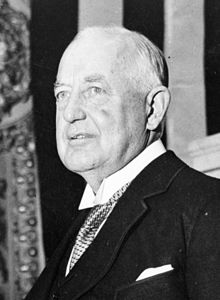Bertrand Snell
| Bertrand Snell | |
|---|---|
 |
|
| House Minority Leader | |
|
In office March 4, 1931 – January 3, 1939 |
|
| Preceded by | John Nance Garner |
| Succeeded by | Joseph William Martin, Jr. |
| Member of the U.S. House of Representatives from New York's 31st district | |
|
In office November 2, 1915 – January 3, 1939 |
|
| Preceded by | Edwin A. Merritt |
| Succeeded by | Wallace E. Pierce |
| Personal details | |
| Born |
December 9, 1870 Colton, New York |
| Died | February 2, 1958 (aged 87) Potsdam, New York |
| Political party | Republican |
| Alma mater | Amherst College |
Bertrand Hollis Snell (December 9, 1870 – February 2, 1958) represented upstate New York in the United States House of Representatives. He was a pro-business, low-tax, isolationist conservative Republican who exemplified the traditional values of his party and fought vigorously against the New Deal, especially regarding taxes.
Elected in 1915 to the House of Representatives from upstate New York's Thirty-first district, Snell, a Republican, served in Congress until he retired in 1939. He was intensely loyal to the regular Republican leaders, only deviating from this fidelity when constituent interests were at stake. Early in his congressional service he offered a bill to make the St. Lawrence River more navigable, which he pursued unsuccessfully for the rest of his days in Congress. When the Saint Lawrence Seaway finally came to fruition during the Dwight D. Eisenhower administration, one of its locks was named after Snell. According to his biographer, Louis A. Barone, Snell, throughout his congressional career, generally opposed federal regulatory interference in the private sector and big spending programs.
In 1923 Snell became chairman of the important House Rules Committee. This position gave him great power in Congress and the Republican party, because he was in a position to frame legislation and legislative strategy. When Nicholas Longworth ascended to the Speakership and John Q. Tilson became majority floor leader in 1925, they, along with Snell, effectively controlled in concert the House of Representatives. Snell's first job as chairman of the Rules Committee was to fend off a challenge by insurgent Republicans and Democrats to ease restrictions on discharge petitions. Snell helped fashion a compromise that allowed regular Republican leaders a modicum of control.
When Longworth became Speaker in 1925, the Old Guard reestablished its dominance in the lower chamber. In this, the regular Republicans were aided by Snell's Rules Committee in restricting Democrats and insurgent Republicans from interfering with President Calvin Coolidge's program of spending cuts and tax reduction. To Democrats' complaints that Snell was too restrictive with the rules, the New Yorker responded that the opposition would undoubtedly do the same if and when they came back to power in the House—which they did. During these years Snell also played a role as a go-between for Congress and his college friend from Amherst, President Coolidge. This was not always a popular job, especially when differences arose between the president and Congress.
...
Wikipedia
